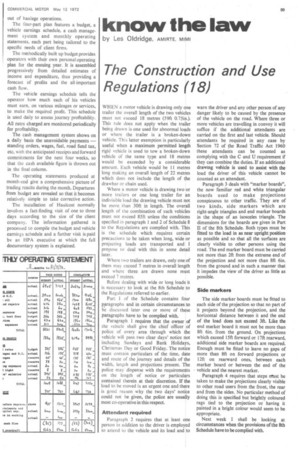know the law
Page 95

If you've noticed an error in this article please click here to report it so we can fix it.
by Les Oldridge, AMIRTE, MIMI
The Construction and Use Regulations (18)
WHEN a motor vehicle is drawing only one trailer the overall length of the two vehicles must not exceed 18 metres (59ft 0.75in.). This rule does not apply when the trailer being drawn is one used for abnormal loads or where the trailer is a broken-down vehicle. This latter exemption is particularly useful when a maximum permitted length rigid vehicle is used to tow a broken-down vehicle of the same type and 18 metres would be exceeded by a considerable amount. Each vehicle would be 11 metres long making an overall length of 22 metres which does not include the length of the drawbar or chain used.
Where a motor vehicle is drawing two or more trailers or one long trailer for an indivisible load the drawing vehicle must not be more than 30ft in length. The overall length of the combination of such vehicles must not exceed 85ft unless the conditions specified in paragraph 1 and 2 of Schedule 8 to the Regulations are complied with. This is the schedule which requires certain precautions to be taken when long, wide or projecting loads are transported and I propose to deal with this in some detail later.
Where two trailers are drawn, only one of them may exceed 7 metres in overall length and where three are drawn none must exceed 7 metres.
Before dealing with wide or long loads it is necessary to look at the 8th Schedule to the Regulations referred to earlier.
Part I of the Schedule contains four paragraphs and in certain circumstances to be discussed later one or more of these paragraphs have to be complied with.
Paragraph 1 requires that the owner of the vehicle shall give the chief officer of police of every area through which the vehicle will pass two clear days' notice not including Sundays and Bank Holidays, Christmas Day or Good Friday. The notice must contain particulars of the time, date and route of the journey and details of the width, length and projections present. The police may dispense with the requirements on the length of notice or particulars contained therein at their discretion. If the load to be moved is an urgent one and there is good reason why the two days' notice could not be given, the police are usually most co-operative in this respect.
Attendant required
Paragraph 2 requires that at least one person in addition to the driver is employed to attend to the vehicle and its load and to warn the driver and any other person of any danger likely to be caused by the presence of the vehicle on the road. Where three or more vehicles are travelling in convoy it will suffice if the additional attendants are carried on the first and last vehicle. Should attendants be required in any case by Section 72 of the Road Traffic Act 1960 these attendants can be counted as complying with the C and U requirement if they can combine the duties. If an additional drawing vehicle is used to assist with the load the driver of this vehicle cannot be counted as an attendant.
Paragraph 3 deals with "marker boards", the now familiar red and white triangular boards used to make projections conspicuous to other traffic. They are of two kinds, side markers which are right-angle triangles and end marker boards in the shape of an isosceles triangle. The dimensions for the boards are given in Part II of the 8th Schedule. Both types must be fitted to the load in as near upright position as possible and so that all the surfaces are clearly visible to other persons using the road. The end marker board must be carried not more than 2ft from the extreme end of the projection and not more than 8ft 6in. from the ground and in such a manner that it impedes the view of the driver as little as possible.
Side markers
The side marker boards must be fitted to each side of the projection so that no part of it projects beyond the projection, and the horizontal distance between it and the end of the load does not exceed 3ft. Like the end marker board it must not be more than 8ft 6in. from the ground. On projections which exceed 15ft forward or 17ft rearward, additional side marker boards are required. Enough must be fitted to leave no gaps of more than 8ft on forward projections or 12ft on rearward ones, between each marker board or between the end of the vehicle and the nearest marker.
Paragraph 4 requires that steps trust be taken to make the projections clearly visible to other road users from the front, the rear and from the sides. No particular method of doing this is specified but brightly coloured rags tied to the projection or having it painted in a bright colour would seem to be appropriate.
Next week I shall be looking at circumstances when the provisions of the 8th Schedule have to be complied with.
















































































































































































































